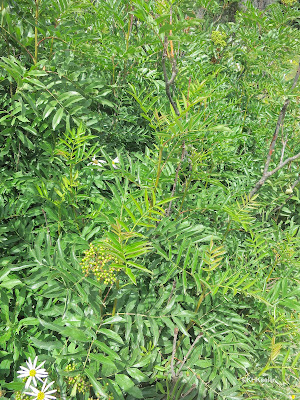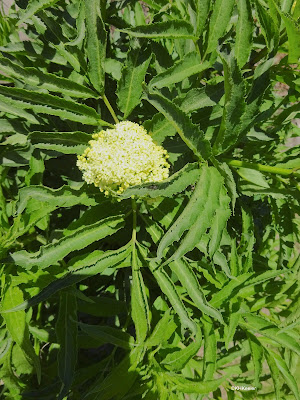Since prehistory times, humans all over the world have collected black elderberries, the fruit of black elder (Sambucus nigra, viburnum family, Viburnaceae) (see previous post: link). The plant has been used medicinally for that long as well. In addition, it grows into a nice tree, 20, sometimes 30, feet tall, with useful wood. The leaves were used as insect repellents. Folklore abounded, some protecting the plant, some considering it accursed. My herbal, traditional, and folklore books have long sections on elder. Here is a selection of what they say.
 |
| black elderberries, Sambucus nigra |
Traditional European medicinal uses of elder included treating coughs and colds, reducing infection and inflamation, treating shortness of breath, to ease lactation, and more. Modern studies found elderberry syrup effective in treating (shortening the duration of) fevers and colds, coughs and bronchitis. Other uses remain unproven. Experts are careful to caution that only fully ripe fruits are safe to consume; unripe fruit, stems, leaves, and bark are all contain enough of the cyanogenic glycoside sambunigrin that they can cause dizziness, headache, nausea, vomitting, and diarrhea.
Treating respiratory problems with elderberry syrup or elderberry wine has a long, long history. The bark and unripe berries were used as purgatives; today there are safer alternatives.
Elder wood is white, light, and polishes nicely, so was historically used for a wide array of small, useful, wooden objects, from pegs to toys, uses that have been replaced by plastic. Where big enough, elder wood was made into furniture. The trees could be pruned into dense shapes and used as hedges.
The leaves, when bruised, have a distinctive scent, called unpleasant but I don't mind it, which was believed to repel pests from flies to aphids to blight, so mashed leaves were applied to garden plants as pesticide. Likewise, lightly crushed leaves were worn on a hat or rubbed on the skin as protection from flies and mosquitos.
Young shoots have a soft core (pith) that is easily removed. The French eat it as moelle de sureau, prepared like asparagus. Early botanists used the pith to hold specimens while they were cut into thin slices for study. The pith could also be used as a candle if cut, dipped in oil, and floated in a cup of water.
 |
| elder leaves |
Hollow stems also made blowguns and popguns for children, stems for pipes, and an array of flutes.
According to one of my sources, elder's oldest English name was aeld which meant fire in Anglo-Saxon, named because the hollow stems were used to blow on a fire. Eld, aeled, does mean fire, but the Oxford English Dictionary traces the name elder back to Middle German names for the plant, with variations such as ellen and ellern, the d sound added long after people stopped speaking Anglo-Saxon. The OED makes no suggestion about what the word meant other than the elder plant.
Sambucus, the scientific name, is based on the name used for elder of the Romans. The Romans apparently made a series of flutes from elder branches, called sambuca (singular sambucus), and they gave their name to the plant or vice versa. (Other instruments, especially a harp-like stringed instrument, have also been called sambuca, I have not seen a satisfactory explantation for flutes and harps having the same name. The sackbut is not related; it was invented in the 15th century and the name came from Latin origins meaning pull or draw).
 |
| elder flowers |
Roman sources wrote about elder as food and medicine but did not report folklore that I can find. The folklore of elder is dominated by northern European tales. In early Anglo-Saxon and Scandinavian myth, a mother goddess, Elle or Hyldemoer, the "Elder Mother" lived in elder trees. She had strong earth magic and avenged any harm to her tree. That carried forward for centuries: one asked permission before cutting any branches from an elder. It was probably part of the source of the Christian beliefs that witches could turn themselves into elder trees, that the disciple Judas hung himself on an elder (though elders do not grow in the Holy Land), and that the tree was unlucky. Christians were likewise careful not to make cradles out of elder because it would torment the child placed there. To bring elder logs indoors brought the devil into the house. Yet this relationship could be exploited: to perceive witches, spread elder juice on your eyelids or light and float bits of pith in a cup and that light will reveal them.
 |
| elderberry flowers |
In relatively recent British folklore, elder was often considered protective. You planted elder by the door you most used, to keep witches and other evil away. They were also often planted around outhouses, dairies and other buildings, to repel insects. Leaves were tied onto farm horses to protect them from flies. On the Isle of Mann, elders were the fairy trees, the trees that fairies most liked to play on. That fed back to the fears of fey folk: if you fell asleep under an elder you might not awake (or awake in Faerie). There is much more folklore (see links below) and many applications I haven't mentioned.
Native Americans had much the same uses as Europeans. They ate elderberries raw (in small amounts), cooked them, and dried them to preserve them. Elder was employed as medicine (emetic, laxative, salve for sores and other skin problems, for jaundice and colic, for toothaches, and more). Elder in various forms was used as an insecticide. Hollow elder stems became medicine tubes, toys like popguns, aids for blowing on fires, and flutes or pipes. The berries and roots were widely used as dyes. I have always been pleased when people on several continents use closely related plants in the same way; if I was doubtful about the use, this is an endorsement.
A famous, useful plant, elder.
Comments and corrections welcome.
References
Cardon, D. 2007. Natural Dyes. Archtype Publications. London.
Grierson, S. 1986. The Colour Cauldron. Mill Books. Perth Scotland.
Grieve, M. 1932. A Modern Herbal. Dover Reprint. Online
Gruenwald, J., T. Brendler and C. Jaenicke, editors. 2004. PDR (Physicians Desk Reference) for Herbal Medicines. 4th edition. Thomson Publishers, Montvale, New Jersey.
Hooke, D. 2010. Trees in Anglo-Saxon England. The Boydell Press. Woodbridge. UK.
Moerman, D. E. 1998. Native American Ethnobotany. BRIT Press, Fort Worth, Texas. online
van Wyk, B-E. 2005. Food Plants of the World. Timber Press, Portland, Oregon.
A variety of websites with English Elder Folklore
Morton, I. 2017. The history of the elder tree: From deities and dryads to Shakespeare and J.K. Rowling. Country Life. link (accessed 1/31/24)
Paghat. No date visible. Black Elder Myths. Paghat's Garden. link
Theresagreen, 2013. The Elder Tree. Theresagreen.me link (Accessed 1/30/24)
Trees for Life. 2024. Elder. link
Note: February 2nd, 2024, was the 11th anniversary of this blog. In those 11 years I never missed getting a post up once a week (late Sunday or early Monday) until this week. This post was half-written when I went on a weekend trip. I caught covid and slept the first part of the week. So I have broken my streak, but I think its okay; surely I do not need to be so serious about a self-imposed deadline. Feeling lousy makes little things, like feeling enough better to finish the post, matters of joy. Enjoy your day.

The way you explain a complex topic in an easy-to-understand way is really impressive. Keep it up.
ReplyDeletepackaging paper box company malaysia
packaging box manufacturer in kuala lumpur
personal care packaging malaysia